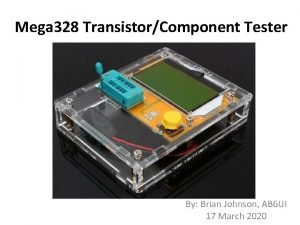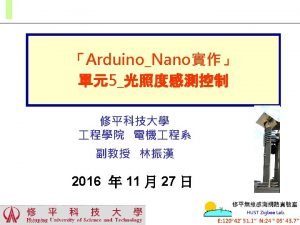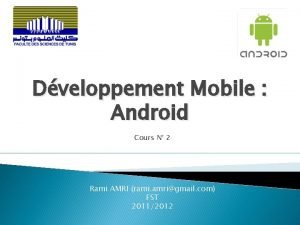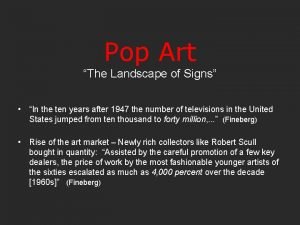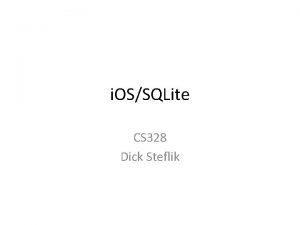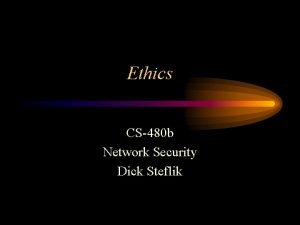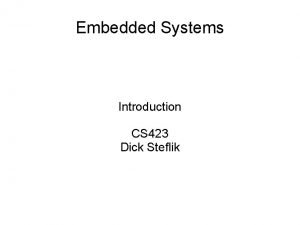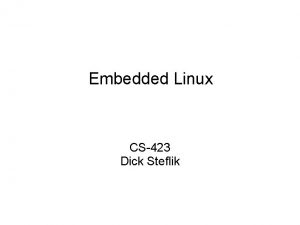Android Life Cycle CS 328 Dick Steflik Life

















- Slides: 17

Android Life Cycle CS 328 Dick Steflik

Life Cycle • The steps that an application goes through from starting to finishing • Slightly different than normal Java life cycle due to : – the difference in the way Android application are defined – the limited resources of the Android hardware platform

Android Applications • Applications are defined to Android via the android manifest file, located in the root of the Eclipse project definition (Android. Manifest. xml) • Double clicking on the Android. Manifest. xml file in the Eclipse project will open the Manifest editor. • The manifest editor is the normal way of creating and modifying the manifest file (defining the app to the system)

Android Applications • An Android application is a collection of activities, an activity correlates to a screen or form that is presented to the user. • The Hello. Android is a simple one screen app that is essentially the same as a Java app run in a terminal/command window. Its Android. Manisest. xml file reflects this :


Android. Manifest. xml <? xml version="1. 0" encoding="utf-8"? > <manifest xmlns: android="http: //schemas. android. com/apk/res/android" package="com. example. helloandroid" android: version. Code="1" android: version. Name="1. 0"> <application android: icon="@drawable/icon" android: label="@string/app_name"> <activity android: name=". Hello. Android" android: label="@string/app_name"> <intent-filter> <action android: name="android. intent. action. MAIN" /> <category android: name="android. intent. category. LAUNCHER" /> </intent-filter> </activity> </application> </manifest>

<manifest> • The manifest tag has the following attributes: – xmlns ; the name of the namespace (android) and where the DTD for the xml parser is located – package ; the name of the java package for this application (must have at least two levels) – android: version ; the version code for this version of the app – android: version. Name ; The version name (for publishing)

<activity> • child tag of <manifest> • need one <activity> tag for each activity of the application • attributes: – android: name; the name of the activity, this will be used as the name of the Java file and the resulting class – android: label; a string that we will be able to programatically retrieve the activity name at run time.

<intent-filter> • Child tag of <activity> • First, what’s an intent? In OO-speak an intent is a message sent from one program to another (message dispatcher) to tell the system what to do next. Typically an intent consists of two parts; an action and the data that action is supposed to use to do it. • When you select an icon on the main page the intent is to run the app associated with that icon • The tag is used to construct an android. content. Intent. Filter object to handle a particular android. content. Intent

<action> • child of <intent-filter> • the action we want done: – Predefined actions of the intent class of android. content ; see the api at: http: //developer. android. com/reference/android/content/Intent. html

<category> • child of <intent-filter> • additional attributes that can be supplied • LAUNCHER – indicates that it should apper in the launcher as a top level application • see the api documentation for more on intent resolution.

Intents • Commonly used Google application intents http: //d. android. com/guide/appendix/g-app-intents. html • Registry of 3 rd party application Intents http: //www. openintents. org/en/intentstable

Whew! • we’ve explained the Hello. Android manifest file, on to Life Cycle and Life cycle management.

Life Cycle • Each application runs in its own process. • Each activity of an app is run in the apps process • Processes are started and stopped as needed to run an apps components. • Processes may be killed to reclaim needed resources. • Killed apps may be restored to their last state when requested by the user

Management • Most management of the life cycle is done automatically by the system via the activity stack. • The activity class has the following method callbacks to help you manage the app: – on. Create() – on. Start() – on. Resume() – on. Pause() – on. Stop() – on. Restart() – on. Destroy()


using the callbacks • To use a callback just overload it in your activity java file. • The lifecycle is explained very well here: http: //developer. android. com/training/basics/activity-lifecycle/index. html • The use of the callbacks is explained in the api documentation for the activity class: http: //developer. android. com/reference/android/app/Activity. ht ml
 Mary poppins robert stevenson
Mary poppins robert stevenson Legge 328 del 2000 slide
Legge 328 del 2000 slide Atmega 328
Atmega 328 Weerklank 437
Weerklank 437 At mega 328
At mega 328 281 en numeros romanos
281 en numeros romanos Arduino adc
Arduino adc Legge 328 del 2000 mappa concettuale
Legge 328 del 2000 mappa concettuale Cycle de vie d'une activité android
Cycle de vie d'une activité android Dick fusbury
Dick fusbury Angelika war dick und rund
Angelika war dick und rund Shame by dick gregory summary
Shame by dick gregory summary Lexical ambiguity
Lexical ambiguity Richard nixon tricky dicky
Richard nixon tricky dicky Richard 'dick' marcinko
Richard 'dick' marcinko Tom dick and harry muscles
Tom dick and harry muscles Claes oldenburg pastry case
Claes oldenburg pastry case Lou carey
Lou carey




